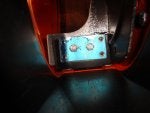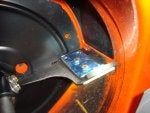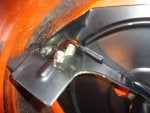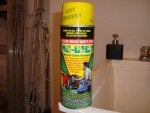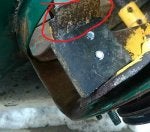I'm in my third season with my Husqvarna ST227P (254cc engine). It moved even "good snowman" snow fairly well, although too wet and I'd wind up re-blowing a lot of the snow in the wide part of the driveway outside the garage, where it flares out to pass also by the side of the garage. But after a storm that dropped an inch or two of snow and then enough rain to leave a half inch of slush at the bottom, I had to handle the mess with the push plow. Otherwise the blower would clog too often, and in between clogs the soggy mess would dump out just a couple of feet to the side. After stalling too long and putting up with doing the slushy jobs by hand, I bought the materials and did the impeller job.
Following a link from another thread on impeller mods, I bought a 3-ft roll of 4" wide 1/4" SBR; the label reads "70 S Shore A, Black, Smooth Finish, No Backing." I found a source of 40x80 mm stainless mending plates online, and from the hardware store I got 1/4" stainless bolts with locking nuts.The bolts are 3/4" long, but I should have used 1" to make it easier to get the nuts on in tight quarters. Below are pics I took this afternoon, with the chute removed. The top two pics show the bolt head side, as the impeller blade is about to pass the chute area. You can see how I bent each plate up to hold the rubber piece as it turns up the curvature of the blade. The first also shows where I notched the rubber where it passes over the chute bolts. The third pic shows the back side of the blade, where the nuts are fastened, and the stiffening groove in the blade. The groove was convenient for starting the bolt holes. I suppose drilling twice in the groove weakens the blade, but that would be offset by having the plate/rubber sandwich bolted on. I used a new 5% cobalt bit at slow speed for the drilling, with the chute off, with an old round cold chisel placed through a chute bolt hole to hold the impeller from turning as I leaned on the drill. A strong magnet was used afterward to clean up the bits of drilled out steel from the housing. The first and third pics also show that the rubber turns up the end of the blade, but not all the way to the tip. The end of the rubber does go outside the chute opening, so I'm not concerned about spillover there.
The last pic shows the can of spray stuff that Tractor Supply sold me when I asked about what they'd recommend to make the inside of the bucket non-stick. It seems to do the job well.
After finishing the job, I took the machine outside and started the engine. After a bit of warmup, I engaged the drive, and I did notice a brief bit of laboring as the impeller was driven around the housing. I didn't run it for too long that way. I figured that the roughness of the housing interior, due to small stones and other crud from two years of blowing, would file down the edges of the rubbers pieces in short order.
Given the snow drought we're having here in NH this year, the only test of the modified machine was in 4-5" of very light snow. Whether it performed better on that stuff is hard to say, as that type of snow sort of aerates quickly ten feet out of the chute and disperses. I'm waiting for something heavier to fall. We've had maybe 3" of light snow today, but tomorrow we're due for some sleet and freezing rain, then maybe back to snow at the end. I'll wait for the end of that, then see what happens to the combination of snow and ice.
An earlier post commented on improved chute velocity. I thought I'd add my own. With an unmodified impeller, snow/slush right at the tip of the impeller should be near the speed of the impeller itself. But right next to the housing, the drag of the housing would slow the speed of the snow considerably, to a fraction of impeller speed, notably when the snow is really sticky or slushy. In between impeller and housing, snow speed would be somewhere in between, falling off rapidly outside of the impeller tip. This layer of reduced-velocity snow/slush likely is what leads to increased chute clogging. Thus it's easy to imagine why having a rubber piece sweeping up snow right to the housing would nearly eliminate that low velocity layer and improve the throw. I doubt that the slightly higher velocity of the very tip of the rubber compared to that at the tip of the impeller blade has a lot to do with the improvement. I think it's mainly the elimination of the low-velocity layer that does the trick.
[Moderator: given that this thread has grown in length considerably and is mostly about impeller modification and not really specific to Honda blowers, should it be moved to the maintenance/repair forum?]





